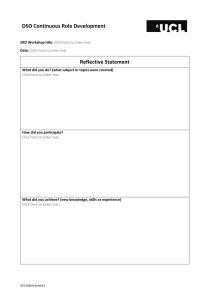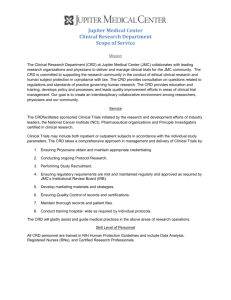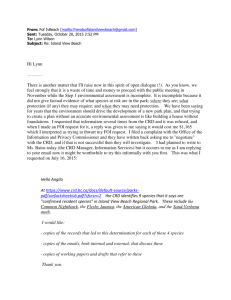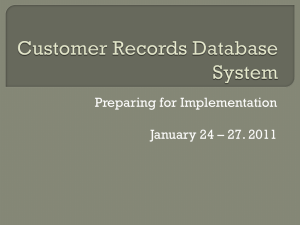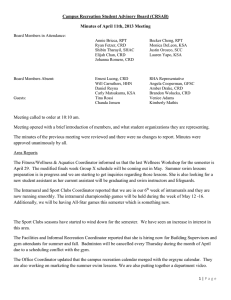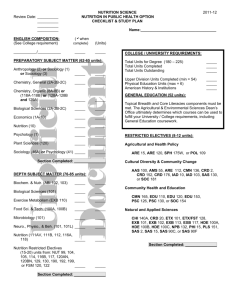PAL Application download
advertisement
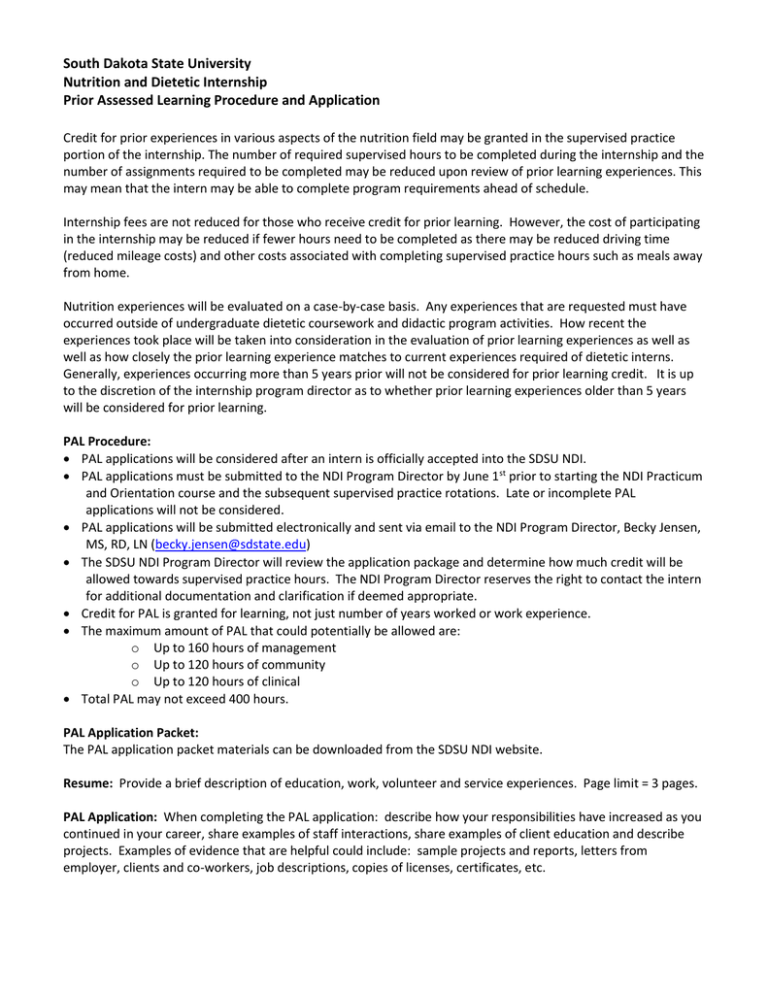
South Dakota State University Nutrition and Dietetic Internship Prior Assessed Learning Procedure and Application Credit for prior experiences in various aspects of the nutrition field may be granted in the supervised practice portion of the internship. The number of required supervised hours to be completed during the internship and the number of assignments required to be completed may be reduced upon review of prior learning experiences. This may mean that the intern may be able to complete program requirements ahead of schedule. Internship fees are not reduced for those who receive credit for prior learning. However, the cost of participating in the internship may be reduced if fewer hours need to be completed as there may be reduced driving time (reduced mileage costs) and other costs associated with completing supervised practice hours such as meals away from home. Nutrition experiences will be evaluated on a case-by-case basis. Any experiences that are requested must have occurred outside of undergraduate dietetic coursework and didactic program activities. How recent the experiences took place will be taken into consideration in the evaluation of prior learning experiences as well as well as how closely the prior learning experience matches to current experiences required of dietetic interns. Generally, experiences occurring more than 5 years prior will not be considered for prior learning credit. It is up to the discretion of the internship program director as to whether prior learning experiences older than 5 years will be considered for prior learning. PAL Procedure: PAL applications will be considered after an intern is officially accepted into the SDSU NDI. PAL applications must be submitted to the NDI Program Director by June 1st prior to starting the NDI Practicum and Orientation course and the subsequent supervised practice rotations. Late or incomplete PAL applications will not be considered. PAL applications will be submitted electronically and sent via email to the NDI Program Director, Becky Jensen, MS, RD, LN (becky.jensen@sdstate.edu) The SDSU NDI Program Director will review the application package and determine how much credit will be allowed towards supervised practice hours. The NDI Program Director reserves the right to contact the intern for additional documentation and clarification if deemed appropriate. Credit for PAL is granted for learning, not just number of years worked or work experience. The maximum amount of PAL that could potentially be allowed are: o Up to 160 hours of management o Up to 120 hours of community o Up to 120 hours of clinical Total PAL may not exceed 400 hours. PAL Application Packet: The PAL application packet materials can be downloaded from the SDSU NDI website. Resume: Provide a brief description of education, work, volunteer and service experiences. Page limit = 3 pages. PAL Application: When completing the PAL application: describe how your responsibilities have increased as you continued in your career, share examples of staff interactions, share examples of client education and describe projects. Examples of evidence that are helpful could include: sample projects and reports, letters from employer, clients and co-workers, job descriptions, copies of licenses, certificates, etc. SDSU NDI Prior Assessed Learning (PAL) Application Name (last): Current address: (first): City: Phone: State: Zip: Email: Identify your different work and life experiences which provide you with advanced knowledge and skills. The "job code" you assign to each experience will be used in Column A in the competency tables. Please note: experiences must be outside of your undergraduate degree assignments, practicum and field experiences. Job Job Title Dates (mm/yy to Person to contact to Brief description Code mm/yy) verify 1 2 3 4 5 6 7 8 9 10 Add additional numbers/lines if needed. Review the skills and activities listed below and then describe, the experiences that have provided you with the described competency. ACEND Competency Job Code Describe work/life or professional/continuing education experiences (excluding college coursework used to complete degree and/or DPD verification.) Describe what was learned. Describe how professional growth was achieved. 1. Scientific and Evidence Base of Practice: integration of scientific information and research into practice. CRD 1.1 Select indicators of program quality and/or customer service and measure achievement of objectives. (Tip: Outcomes may include clinical, programmatic, quality, productivity, economic or other outcomes in wellness, management, sports, clinical settings, etc.) CRD 1.2 Apply evidence-based guidelines, systematic reviews and scientific literature (such as the Academy’s Evidence Analysis Library and Evidence-based Nutrition Practice Guidelines, the Cochrane Database of Systematic Reviews and the U.S. Department of Health and Human Services, Agency for Healthcare Research and Quality, National Guideline Clearinghouse Web sites) in the nutrition care process and model and other areas of dietetics practice. CRD 1.3 Justify programs, products, services and care using appropriate evidence or data. CRD 1.4 Evaluate emerging research for application in dietetics practice. CRD 1.5 Conduct projects using appropriate research methods, ethical procedures and data analysis. 2. Professional Practice Expectations: beliefs, values, attitudes and behaviors for the professional dietitian level of practice. CRD 2.1 Practice in compliance with current federal regulations and state statutes and rules, as applicable and in accordance with accreditation standards and the Scope of Dietetics Practice and Code of Ethics for the Profession of Dietetics. CRD 2.2 Demonstrate professional writing skills in preparing professional communications. (Tip: Examples include research manuscripts, project proposals, education materials, policies and procedures.) CRD 2.3 Design, implement and evaluate presentations to a target audience. (Tip: A quality presentation considers life experiences, cultural diversity and educational background of the target audience.) CRD 2.4 Use effective education and counseling skills to facilitate behavior change. CRD 2.5 Demonstrate active participation, teamwork and contributions in group settings. CRD 2.6 Assign patient care activities to DTRs and/or support personnel as appropriate. (Tip: In completing the task, students/interns should consider the needs of the patient/client or situation, the ability of support personnel, jurisdictional law, practice guidelines and policies within the facility.) CRD 2.7 Refer clients and patients to other professionals and services when needs are beyond individual scope of CRD 2.8 CRD 2.9 practice. Apply leadership principles to achieve desired outcomes. Participate in professional and community organizations. (Tip: Professional and Community Organizations Community-based supervised practice experiences need not take place in a dietetics-related organization. Experiences may occur in local community organizations such as United Way, food banks such as Second Harvest, or even faithbased organizations such as the Salvation Army. Experiences can also occur at sister units of the program within the parent organization such as an outpatient clinic or a campus fitness center. Professional and community organizations provide many opportunities for students to develop leadership skills. They do not have to hold an elected position to demonstrate leadership. For example, the program can create community based projects where a group of students is asked to serve under the leadership of another student. After a task or set of tasks is successfully accomplished, another student may be selected to lead the group in accomplishing CRD 2.10 CRD 2.11 CRD 2.12 CRD 2.13 different tasks, until eventually, all students get to take a leadership role.) Establish collaborative relationships with other health professionals and support personnel to deliver effective nutrition services. (Tip: Other health professionals include physicians, nurses, pharmacists, etc.) Demonstrate professional attributes within various organizational cultures. (Tip: Professional attributes include showing initiative and proactively developing solutions, advocacy, customer focus, risk taking, critical thinking, flexibility, time management, work prioritization and work ethic.) Perform self assessment, develop goals and objectives and prepare a draft portfolio for professional development as defined by the Commission on Dietetic Registration. Demonstrate negotiation skills. (Tip: Demonstrating negotiating skills includes showing assertiveness when needed, while respecting the life experiences, cultural diversity and educational background of the other parties.) 3. Clinical and Customer Services: development and delivery of information, products and services to individuals, groups and populations. CRD 3.1 Perform the Nutrition Care Process (a through e below) and use standardized nutrition language for individuals, groups and populations of differing ages and health status, in a variety of settings. CRD 3.1.a Assess the nutritional status of individuals, groups and populations in a variety of settings where nutrition care is or can be delivered. CRD 3.1.b Diagnose nutrition problems and create problem, etiology, signs and symptoms (PES) statements. CRD 3.1.c Plan and implement nutrition interventions to include prioritizing the nutrition diagnosis, formulating a nutrition prescription, establishing goals and selecting and managing intervention. CRD 3.1.d Monitor and evaluate problems, etiologies, signs, symptoms and the impact of interventions on the nutrition diagnosis. CRD 3.1.e Complete documentation that follows professional guidelines, guidelines required by health care systems and guidelines required by the practice setting. CRD 3.2 Demonstrate effective communications skills for clinical and customer services in a variety of formats. (Tip: Formats include oral, print, visual, electronic and mass media methods for CRD 3.3 CRD 3.4 CRD 3.5 CRD 3.6 maximizing client education, employee training and marketing.) Develop and deliver products, programs or services that promote consumer health, wellness and lifestyle management. (Tip: Students/Interns should consider health messages and interventions that integrate the consumer’s desire for taste, convenience and economy with the need for nutrition and food safety.) Deliver respectful, sciencebased answers to consumer questions concerning emerging trends. (Tip: Students/Interns should demonstrate and promote responsible use of resources including employees, money, time, water, energy, food and disposable goods.) Coordinate procurement, production, distribution and service of goods and services. Develop and evaluate recipes, formulas and menus for acceptability and affordability that accommodate the cultural diversity and health needs of various populations, groups and individuals. 4. Practice Management and Use of Resources: strategic application of principles of management and systems in the provision of services to individuals and organizations. CRD 4.1 Participate in management of human resources. CRD 4.2 Perform management functions related to safety, security and sanitation that affect employees, customers, patients, facilities and food. CRD 4.3 Participate in public policy activities, including both legislative and regulatory initiatives. CRD 4.4 Conduct clinical and customer service quality management activities. CRD 4.5 Use current informatics technology to develop, store, retrieve and disseminate information and data. CRD 4.6 Prepare and analyze quality, financial or productivity data and develops a plan for intervention. CRD 4.7 Propose and use procedures as appropriate to the practice setting to reduce waste and protect the environment. (Tip: Students/Interns are encouraged to promote environmentally-friendly practices, so that future generations have the water, materials, and resources to protect human health and life on the planet. Practical steps include using local ingredients; not wasting food and resources; using efficacious, non-toxic products when available; properly disposing of toxic materials; reusing containers and products; recycling when possible; purchasing products with recycled content; and teaching others the value of CRD 4.8 CRD 4.9 CRD 4.10 CRD 4.11 sustainability.) Conduct feasibility studies for products, programs or services with consideration of costs and benefits. Analyze financial data to assess utilization of resources. Develop a plan to provide or develop a product, program or service that includes a budget, staffing needs, equipment and supplies. Code and bill for dietetic/nutrition services to obtain reimbursement from public or private insurers. Community Nutrition Concentration Area Competencies Specific to the SDSU NDI CN 5.1 Utilize an interdisciplinary approach to complete a community needs assessment involving an area of nutrition, health and wellness or physical activity. CN 5.2 Utilize needs assessment findings and a theoretical framework for planning, implementing, evaluating and sustaining a program. CN 5.3 Provide at least one component of a community-driven program, assess outcomes and document impact. PAL Application adapted from the prior assessed learning application found online at Iowa State University.
